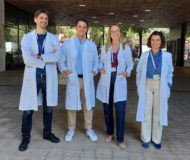

Dr. Íñigo Rodríguez Baz, from the Neurobiology of Dementias Group at the Sant Pau Research Institute and the Memory Unit at Hospital Sant Pau, has been awarded a grant from the Alzheimer’s Association. This support will enable the development of a project aimed at improving the biological diagnosis of neurodegenerative diseases that cause dementia.
The Alzheimer’s Association grants are awarded to researchers worldwide whose projects are of high quality and relevance to advancing knowledge of Alzheimer’s disease and related dementias. Receiving this distinction represents a mark of excellence for research at IR Sant Pau.
This support will strengthen and expand the pioneering work already being carried out at Sant Pau using the Seed Amplification Assay (SAA), an innovative technique that allows for the highly sensitive detection of alpha-synuclein in cerebrospinal fluid. This protein, when abnormally aggregated inside neurons, causes cell death and is associated with diseases such as dementia with Lewy bodies and Parkinson’s disease, although it can also be found in some cases of Alzheimer’s disease.
At Sant Pau, thanks to close collaboration between the Biochemistry Service and the Memory Unit, SAA is already being applied in research practice, positioning the hospital as a reference center in the development of biomarkers for synucleinopathies—neurodegenerative diseases in which the alpha-synuclein protein accumulates abnormally in the brain.
Until recently, alpha-synuclein was very difficult to detect, so diagnoses relied mainly on clinical evaluation. With SAA, implemented at Sant Pau by the Biochemistry Service, it is now possible to detect minimal amounts of misfolded alpha-synuclein. This technique will not only make it possible to identify the presence of the protein but also to analyze how it behaves in each disease and verify whether laboratory results match findings from autopsies, thus strengthening the biological diagnosis.
“This technique opens an extraordinary avenue for the early detection of these pathologies and for differentiating them from one another with greater precision,” explains Dr. Rodríguez Baz. “With our study, we aim to validate its use in a large cohort of patients and determine how it relates to other biomarkers from neuroimaging, fluid analysis, and reference neuropathological findings.”
The Sant Pau team will analyze more than 1,500 samples from individuals with different clinical profiles: patients with dementia with Lewy bodies, sporadic Alzheimer’s disease, Alzheimer’s disease associated with Down syndrome, and cognitively healthy older adults. In addition, the study will consider factors such as age, sex, genetics (apolipoprotein E), and ethnic background to better understand how they influence alpha-synuclein aggregation and the biological variability of these diseases. The project will last for three years, be mentored by Drs. Juan Fortea and Daniel Alcolea, and include collaboration from Dr. Mireia Tondo and Rosa Ferrer of the Biochemistry Service at Hospital Sant Pau, where the SAA analyses are carried out.
This work could also help distinguish between primary and secondary alpha-synuclein aggregations. In diseases known as synucleinopathies—such as dementia with Lewy bodies or Parkinson’s disease—the protein appears as a primary aggregation, meaning it is the main cause of brain damage. In contrast, in some cases of Alzheimer’s disease, it may appear as a secondary aggregation, accompanying other disease-related alterations. This distinction is crucial because the presence of secondary alpha-synuclein is associated with a worse prognosis, faster symptom progression, and greater challenges in developing effective treatments. Being able to identify this phenomenon early and accurately would represent a major step forward in understanding the disease and guiding therapeutic strategies.
Furthermore, this project aims to fill key gaps in current research by providing new biomarkers, refining disease stratification, and improving understanding of mixed forms of dementia in which different pathological processes converge.
This pioneering research could mark a turning point in the way dementia is diagnosed, enabling earlier and more accurate diagnoses, better patient selection for clinical trials, and more effective development of personalized therapies. “Our ultimate goal is for patients to receive the correct diagnosis sooner and, with it, the most appropriate treatment and care,” says Dr. Rodríguez Baz.